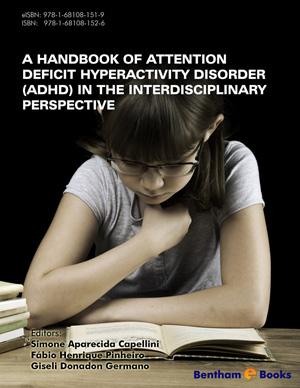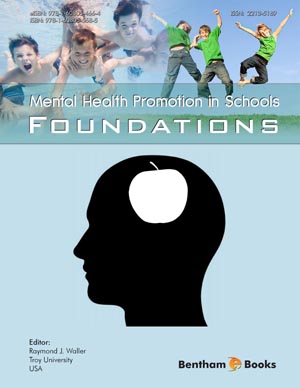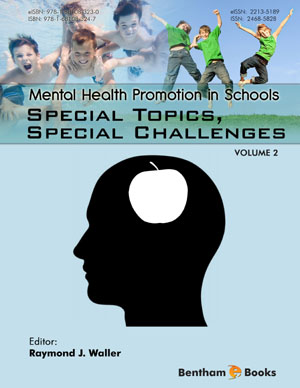Summary of eBook
Page: i-i (1)
Author: Simone Aparecida Capellini, Fábio Henrique Pinheiro and Giseli Donadon Germano
DOI: 10.2174/9781681081519116010001
Preface
Page: v-v (1)
Author: Simone Aparecida Capellini, Fábio Henrique Pinheiro and Giseli Donadon Germano
DOI: 10.2174/9781681081519116010003
Contributors
Page: vii-viii (2)
Author: Simone Aparecida Capellini, Fábio Henrique Pinheiro and Giseli Donadon Germano
DOI: 10.2174/9781681081519116010004
Genetics Findings in Attention Deficit Hyperactivity Disorder
Page: 3-17 (15)
Author: Lucilene Arilho Ribeiro-Bicudo
DOI: 10.2174/9781681081519116010005
PDF Price: $15
Abstract
Attention deficit hyperactivity disorder (ADHD) is characterized by persistent and pervasive symptoms of inattention, hyperactivity, and impulsivity. ADHD is known as a ‘complex trait’ because of a phenotype with a genetic etiology that is composed of a multitude of susceptibility genes, each contributing only a small magnitude of the overall risk for the disorder. As so, this chapter aimed to establish a short review of the literature regarding to the genetics findings of ADHD. It is now well established that ADHD runs in families and is strongly genetically influenced. Also, studies have indicated a high heritability of ADHD (between 60% and 91%). Recent studies as the whole genome association (WGA) has showed an implicating specific susceptibility genes for ADHD. Regarding the genes in ADHD, studies have showed some candidate gene, related with the dopamine and serotonin genes. Also, it is important to highlight that the aetiology of ADHD, like all complex disorders, is not entirely explained by genes; environmental factors also contribute. So, in conclusion, all of the associated gene variants have been of small effect and in the future there will be increasing interest in examining the risk effects of multiple genes (gene-gene interaction) and interaction with environmental risk factors.
Characterization of Cognitive-Linguistic Profile and Neuroimaging in Attention Deficit Hyperactivity Disorder
Page: 19-29 (11)
Author: Giseli Donadon Germano and Simone Aparecida Capellini
DOI: 10.2174/9781681081519116010006
PDF Price: $15
Abstract
This chapter aimed to establish a short review of the literature regarding to the cognitive-linguistic profile and neuroimaging findings of Attention Deficit Hyperactivity Disorder (ADHD). Neuroimaging researchers had pointed some anatomical and functional alterations in ADHD. These findings are consistent with cognitive-linguistic profiles, such as inhibition of response, deficit in executive function and working memory and attention deficits. Children with ADHD may also experience reading and writing difficulties (make more errors in linguistic tasks such as reading, phonology, rapid naming) and have rare linguistics resources (lack of words or fragments of information omission resulting in an incoherent speech, change the logical order of prayer and the production of discourses confused). However, it´s important to highlight that such manifestations are secondary consequences of the problems inherent in the regulation and attention and self-regulation in ADHD.
Reading Processes in Students with Attention Deficit Disorder with Hyperactivity
Page: 31-40 (10)
Author: Monique Herrera Cardoso and Adriana Marques de Oliveira
DOI: 10.2174/9781681081519116010007
PDF Price: $15
Abstract
This chapter aimed to characterize the performance of students with Attention Deficit Hyperactivity Disorder (ADHD) and to compare that with the performance of students with good academic performance on the reading assessment processes. Methods: Forty students took part in this study. Their ages ranged from 8:2 years old to 10:11 years old, and they belonged to both genders. These students attended from 1st to 4th grades of elementary school. They were divided into two groups: GI - 20 students with interdisciplinary diagnosis of ADHD, and GII - 20 students with good academic performance, paired up with GI according to gender, age and school level. The students were submitted to the application of a Brazilian adaptation of the assessment of the reading processes – PROLEC, composed of four blocks: identification of letters, lexical, syntactic and semantic processes. Results: a statistically significant difference was found between GI and GII in the Prolec tests, with the exception of the same-different and lexical-decision tests, indicating that the students of GI presented lower performance when compared with students of GII. Regarding the classification of the results of Prolec, there was a statistically significant difference in the lexical, syntactic and semantic processes and the letter-sound test, with the exception of the same-different test of the process of letter identification. Conclusion: The findings suggest that the group of students with ADHD shows lower performance compared to the group without problems, highlighting that the attentional factor affects the cognitive functions impairing the acquisition of skills necessary to the learning of reading.
Comparison of the Performance of Students with Attention Deficit Hyperactivity Disorder in Phonological Tasks and Reading with Good Readers
Page: 41-55 (15)
Author: Vera Lúcia Orlandi Cunha and Cláudia da Silva
DOI: 10.2174/9781681081519116010008
PDF Price: $15
Abstract
This chapter aimed to compare and characterize the performance on metalinguistic skills and reading for students with attention deficit hyperactivity disorder (ADHD) and students without behavioral disorders and/or learning disabilities. The study included 20 students from 5th to 8th grade level of elementary school, 14 students were males and six females, aged between 9-13 years. The student has divided in: Group I (GI): composed of 10 students with an interdisciplinary diagnostic ADHD, and Group II (GII): composed of 10 students without complaints of behavioral disorders and/or learning disabilities. With the procedure was used as Tests of metalinguistic skills and reading of the PROHMELE, compost of tests of syllabic and phonemic identification, tests of syllabic and phonemic manipulation, repetition of non-words and reading tests. The results showed statistically significant differences among GI and GII showing that students of the group GI presented lower performances in post when compared with the students of the group GII. The findings of this study allowed us to conclude that the difficulties presented in these PROHMELE skills by students with ADHD can’t be attributed to a primary deficit, but as a phenomenon secondary to inattention that interfere directly in their performance.
Visual Perception of Students with Attention Deficit and Hyperactivity Disorder
Page: 57-69 (13)
Author: Paola Matiko Martins Okuda and Giseli Donadon Germano
DOI: 10.2174/9781681081519116010009
PDF Price: $15
Abstract
This chapter aimed to characterize and compare the viso-motor perception of students with attention deficit hyperactivity disorder (ADHD) and students with good academic performance. Methods: Forty male students (100%) from the 2nd to the 5th grades of an elementary public school, aged between 7 to 10 years and 8 months old participated in the study. They were divided into two groups: GI (20 students with attention deficit hyperactivity disorder) and GII (20 students with good academic performance), paired according to age, grade level, and gender. The students were submitted to the Developmental Test of Visual Perception. Results: Students of GI presented inferior performance in spatial position and visual closure (reduced motor) when compared to GII and performance equivalent to lower age students in reduced motor perception. Conclusion: The difficulties in viso-motor perception presented by students of GI cannot be attributed to a primary deficit, but to a secondary phenomenon of inattention that directly interferes in their viso-motor performance.
Developmental Coordination Disorders
Page: 71-80 (10)
Author: Amanda Kirby
DOI: 10.2174/9781681081519116010010
PDF Price: $15
Abstract
Developmental coordination disorder (DCD) is defined on the basis of a failure of the acquisition of skills in both gross and fine movements, which is not explicable on the basis of impaired general learning and similar exposure to opportunity to gain motor skills as their peers. Increasing interest in these children, in academic research and in clinical and educational practice, has focused on the need not only for early identification. As so, the aim of this chapter was to make a short review of the literature, highlighting the importance of definition, the diagnostic´s criteria (identification and classification) and the intervention.
Orthographic Performance of Students with Attention Deficit Hyperactivity Disorder According to the Error Semiology
Page: 81-95 (15)
Author: Simone Aparecida Capellini and Andrea Oliveira Batista
DOI: 10.2174/9781681081519116010011
PDF Price: $15
Abstract
This chapter aimed to characterize, to compare and to classify the orthographic performance of attention deficit hyperactivity disorder (ADHD, according to the error semiology. The participants of this study were 36 students from the 3rd to the 5th grade level of the elementary school, divided in group I (GI): composed by 18 students with an interdisciplinary diagnosis of Attention Deficit Hyperactivity Disorder (ADHD), 60% male and 40% female, and group II (GII): composed by 18 students with a good academic performance, paired by gender, age, and grade, level according to GI. The students were submitted to Orthographic Evaluation Protocol (Pro-Orthography), in the following order: Collective Version: 1- Writing of alphabet letters, 2- Dictation at random of the alphabet letters, 3- Word dictation, 4- Pseudo words dictation, 5- Dictation with pictures, 6- Thematic writing motivated by a picture, and Individual Version: 7- Dictation of phrases, 8- Purposeful error, 9- Spelling dictation, 10- Orthographic lexical memory. The classification of errors was accomplished in the two types: the natural orthography and the arbitrary orthography. The results showed that those students present more difficulty in the use of the orthographic conventions on their writing, hampering their learning, mainly owing to the lack of attention, which modify the phonological work memory and the planning of writing. The data obtained indicate the existence of a profile that is not orthographic in the writing of the students with ADHD.
Multidisciplinary Intervention for Student with Attention Deficit Hyperactivity Disorder
Page: 97-111 (15)
Author: Cláudia da Silva, Maria Dalva Lourenceti and Fábio Henrique Pinheiro
DOI: 10.2174/9781681081519116010012
PDF Price: $15
Abstract
The purpose of this chapter is to provide intervention strategies for students with ADHD, seeking a work that involves parents, with orientation; the educators, offering intervention strategies in the classroom, orientations as to behavior, and adaptations in their own environment school, and other professionals involved in the rehabilitation of this disorder, offering the choice of behavior and learning strategies appropriate for different situations. The activities aimed to develop aspects of speech (for language development, vocabulary expansion and textual integration), phonological processing skills (favoring the development of mechanisms for reading and writing), motor coordination (looking for improvement in the textual structure and formation of the letters), reading comprehension (for the extraction of information about the material read), and in general, some specific difficulties observed in the academic context (such a sustained attention and concentration, minimizing stimuli that can increase hyperactivity). The intervention strategies proposed prioritize the needs of students with ADHD, and focus of intervention is to increase the frequency and duration of appropriate behaviors, in different situations.
Long Latency Auditory Evoked Potential in Children with Attention Deficit Hyperactivity Disorder
Page: 113-120 (8)
Author: Ana Carla Leite Romero, Simone Aparecida Capellini and Ana Claúdia Figueiredo Frizzo
DOI: 10.2174/9781681081519116010013
PDF Price: $15
Abstract
Comorbidities in Attention Deficit Hyperactivity Disorder (ADHD) and auditory processing disorders in children have been described in the literature. These symptoms have been neglected in the evaluation and rehabilitation of these children. Objective: The purpose of this study was to describe Long Latency Auditory Evoked Potentials (LLAEP) in children with ADHD. Material and Method: Fifteen children with ADHD, aged from 8 to 12 years, participated in this study. LLAEP were recorded as children performed active frequency discrimination (P300f) and duration discrimination tasks (P300d). Results: Data show that children with ADHD had larger amplitude responses in P2 and N2 in the left ear, and delayed latency of N2 in the left ear. Conclusions: The present study contributed to increased knowledge of central auditory pathways in children with ADHD, when observed by electrophysiology recording.
Guide for Parents and Teachers of Students with Attention Deficit Hyperactivity Disorder
Page: 121-128 (8)
Author: Fábio Henrique Pinheiro, Vera Lucia Orlandi Cunha and Cláudia da Silva
DOI: 10.2174/9781681081519116010014
PDF Price: $15
Abstract
The purpose of this chapter is demonstrate the importance of participation of parents or guardians, teachers who deal with Attention Deficit Hyperactivity Disorder (ADHD) in the process of intervention and for this to occur properly and promote the development of children and adolescents with the behaviour disorder, to this end this chapter provide some guidelines to minimize the difficulties, whether with respect to behavior or cognitive linguistic changes made.
Subject Index
Page: 129-132 (4)
Author: Simone Aparecida Capellini, Fábio Henrique Pinheiro and Giseli Donadon Germano
DOI: 10.2174/9781681081519116010015
Introduction
Attention Deficit Hyperactivity Disorder (ADHD) is a genetic and neurological condition that compromises the academic performance of children. From an educational context, knowledge about the cognitive-linguistic difficulties faced by these students can improve the academic and social quality life of affected children. This handbook presents an interdisciplinary perspective of Attention Deficit Hyperactivity Disorder (ADHD). Educators and healthcare professionals can broaden their knowledge of the clinical and educational characteristics of students with ADHD. Topics covered in the handbook include the clinical features and genetics of ADHD, educational guidelines on reading, writing and learning processes and multidisciplinary interventions. Parents and teachers can apply the information in this handbook to assist children with ADHD in the classroom.












